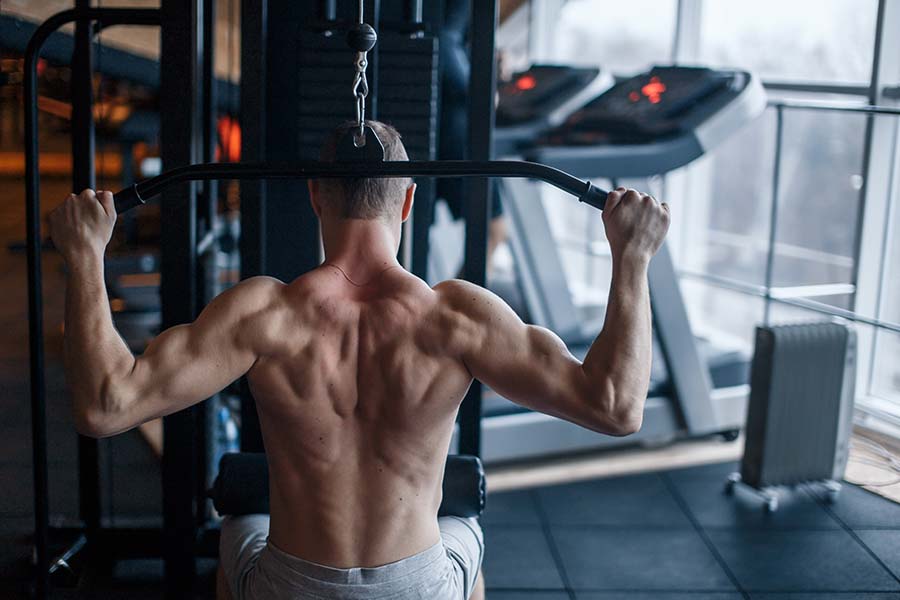In today's increasingly health and fitness-conscious society, one of the most sought-after goals for many individuals is how to get wider shoulders to obtain a strong, aesthetically pleasing physique. A key component of such a desired appearance has broad, muscular shoulders that exude power, confidence, and athleticism.
The shoulders are composed of the deltoid muscle group and are crucial in executing various upper body movements that contribute significantly to one's overall physical function as well as upper body proportions. Developing wider shoulders enhances physical attractiveness, improves posture and stability and reduces the risk of injury in daily activities or training regimens.
There are several paths to achieving this goal, combining discipline, targeted strength training exercises, and nutritional strategies tailored to support muscle growth and maintenance. The following sections will delve deeper into various methods, techniques, and tips for developing wider, stronger shoulders while ensuring a sustainable and healthy route.
Related Article: How to Strengthen Your Shoulders and Get the Muscles You Want
Muscles Overview

Developing broad shoulders requires gaining muscle in the right places. Like building a wider neck, your shoulder span depends on how much muscle you can add to your existing skeletal structure.
Four groups of muscles contribute to this perception, and if you can target all of them during your regular workouts, you will be well on your way to gaining shoulder size.
Delts
Your deltoids are the show's star in developing shoulder width. If you want to broaden your shoulders, you should concentrate on your mid-delts in particular. They are divided into three sections, with the anterior, posterior, and medial delts forming the triangle-shaped protectors of your shoulder joint.
Your objective is to maximize the growth of these muscles to expand your shoulder width. Your middle delts, in particular, will require much attention if you wish to develop your outward-facing muscles.
Trapezius
Your traps assist in keeping your shoulders retracted. Without the support of your traps, you will naturally begin to slouch forward. Therefore, it's important to devote a great deal of time to training your front half.
Traps that are trained effectively will support your chest. This way, you won't have to constantly adjust your posture throughout the day so that your shoulders don't form a crescent shape despite your efforts.
Lats
The lats are positioned along the lower back. While they may not always be the most significant nodes in this network, they are essential for improving your posture and traps. If you want to project strength and confidence, giving the impression of significantly broader shoulders, you need the support that your lats provide for your lower back.
Pecs
Your pectoral muscles are not precisely located on your shoulders. In fact, they only connect to this region in a few peripheral locations. Your pecs primarily consist of a group of broad muscles that cover the upper portion of your chest. They extend from your clavicle and sternum, cross your chest, and attach again to your rips.
Functionally, they help provide your upper arms with pushing power and a degree of rotation. Additionally, your pecs are essential to your posture and the energy you project to the world.
If you can strengthen your pecs, you will have a much broader chest; if you can broaden your chest, this will give the impression that your shoulders are also broader. Chest exercises can be extremely beneficial if you feel your progress has stalled.
Related Article: What are Deltoid Muscles? 6 Best Shoulder Isolation Exercises for Men to Get Bigger Deltoids
10 Best Exercises to Get Wider Shoulders
Achieving broader, muscular shoulders enhances physical appearance and improves overall strength and stability. Your upper body becomes more balanced and proportional with wider shoulders, giving you that coveted V-shaped silhouette.
Developing your deltoids, trapezius, and other supporting muscles boosts your athletic performance and reduces the risk of injury during workouts and everyday activities.
Consequently, incorporating comprehensive shoulder exercises into your fitness routine becomes crucial. So, get ready to level up your workout game and build those broader, more powerful shoulders with these top exercises.
1. Bench Press
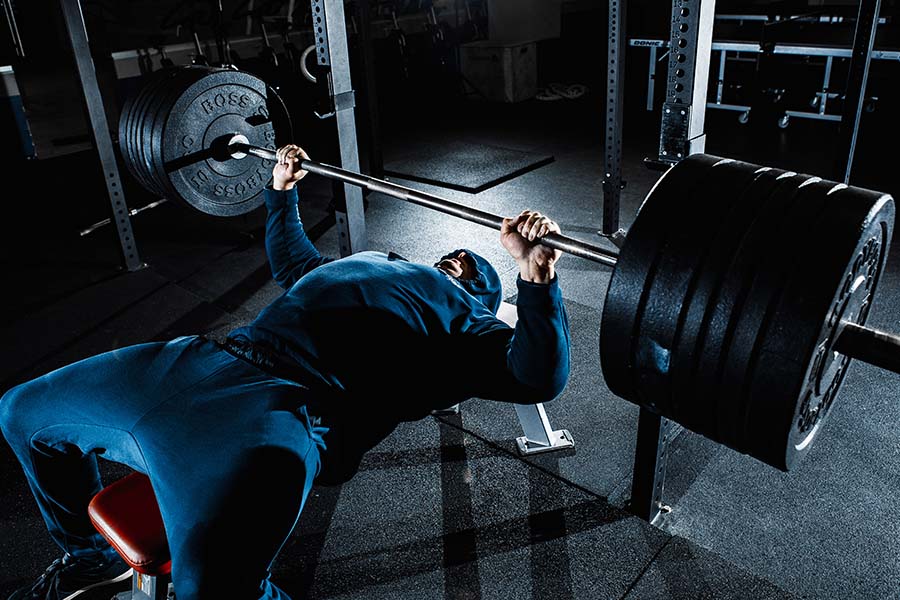
The bench press is a classic upper-body strength-training exercise that targets the pectoral muscles, triceps, and shoulders. It is often considered a benchmarking exercise for measuring upper body strength and power. The bench press is a versatile addition to any workout regimen with numerous benefits and variations.
How to Perform the Bench Press Exercise:
- Position yourself on a flat bench with your feet firmly planted on the ground. Make sure your head, shoulders, and buttocks are in contact with the bench.
- Grasp a powerlifting barbell with a grip slightly wider than shoulder-width apart. Your palms should be facing away from your body, and the bar should be aligned with the middle of your chest.
- Take a deep breath and slowly lift the bar off the rack, holding it above your chest with your arms extended. Ensure that your wrists and elbows are stacked and your shoulders are retracted and stable.
- Lower the barbell to your chest by bending your elbows and allowing your shoulder blades to move apart. Ensure the barbell maintains a straight path as it descends and lightly touches your mid-chest.
- Press the barbell upwards by engaging your pectoral muscles, triceps, and shoulders. Make sure to exhale as you drive the barbell back to the starting position with your arms fully extended.
- Repeat the movement for the desired number of repetitions, maintaining controlled and deliberate form for each rep.
2. Incline Press
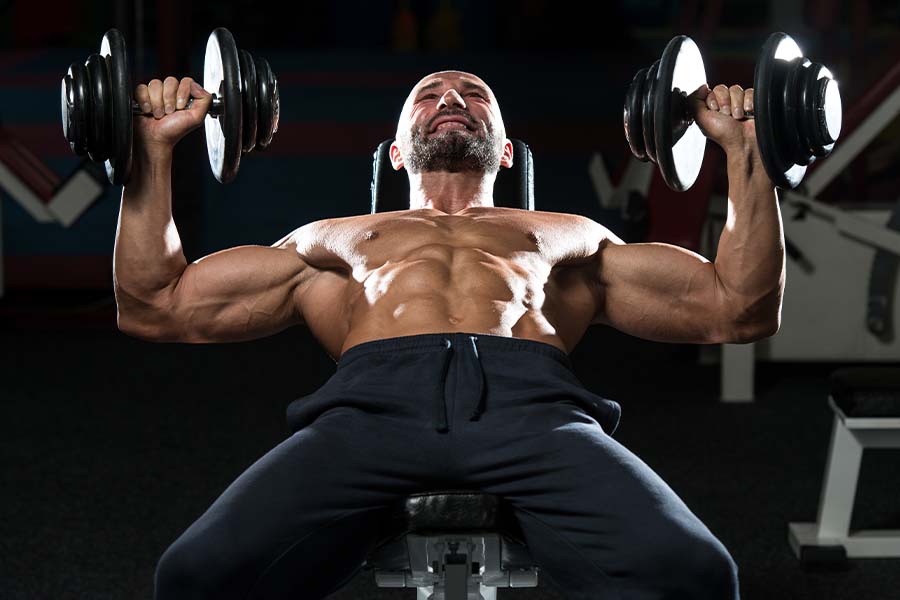
The Incline Press is an excellent upper-body exercise that focuses on developing and strengthening the pectoral, shoulder, and triceps muscles. This compound movement also works the stabilizing muscles, such as the serratus anterior and the trapezius, while improving core strength and stability.
To perform the Incline Press effectively, follow these simple steps:
- Set up the bench at a 30 to a 45-degree incline, with the weight loaded onto a barbell, or utilize appropriately weighted dumbbells.
- Sit on the bench with your feet planted firmly on the floor, about shoulder-width apart. Your back should be flush against the bench, and your core should be engaged.
- If using a barbell, hold the barbell in an overhand grip with your hands slightly wider than shoulder-width apart. If using dumbbells, start with your arms extended and the dumbbells directly above your shoulders.
- Slowly lower the weight towards your chest, maintaining control and keeping your elbows at a 45-degree angle from your body.
- Once the weight is around chest level or slightly below, press the weight back up to the starting position, fully extending your arms without locking out your elbows.
- Repeat this movement for your desired number of repetitions, focusing on using your chest and shoulder muscles to press the weight and maintain proper form throughout the entire exercise.
3. Lateral Raise

The lateral raise is a highly effective upper-body exercise that primarily targets the shoulders, specifically the medial or side deltoids. Incorporating lateral raises into your workout routine provides numerous benefits, including improved muscle strength, joint stability, and enhanced aesthetics.
How to Perform Lateral Raise Exercise:
- Prepare by standing with your feet hip-width apart, holding a dumbbell in each hand with a neutral grip (palms facing your thighs). Your arms should be fully extended and shoulders rolled back and down.
- With a slight bend in your elbows, slowly raise the dumbbells to the side until they are at shoulder height, maintaining control throughout the movement. Your palms should face the ground, and the dumbbells should be perpendicular to the ground.
- Pause for a moment at the top of the movement before lowering your arms back to the starting position in a controlled manner. This completes one repetition.
- Repeat the exercise for the desired number of sets and reps, usually ranging between 3-5 sets of 8-12 repetitions.
4. Half-Kneeling One-Arm Kettlebell Press
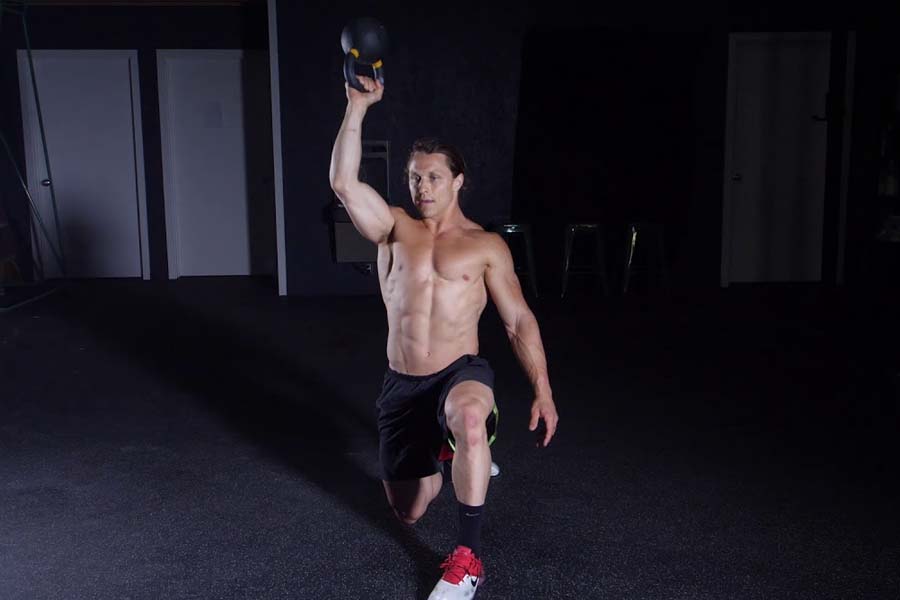
The Half-Kneeling One-Arm Kettlebell Press is a fantastic exercise that provides numerous benefits to anyone looking to improve their strength, balance, and overall fitness. Incorporating this exercise into your workout routine can help target essential muscles, increase stability, and enhance athletic performance.
How to Perform the Half-Kneeling One-Arm Kettlebell Press:
- Begin by placing a kettlebell on the ground beside you. Get into a half-kneeling position, with your right knee on the ground and your left foot planted firmly on the ground in front of you.
- Engage your core and maintain an upright posture, looking straight ahead. Pick up the kettlebell with your right hand, and bring it to a front rack position, meaning the kettlebell is at your shoulder with your wrist straight and your elbow tucked in close to your body.
- Slowly and with control, press the kettlebell overhead by fully extending your right arm. Keep your wrist straight, and make sure your bicep is close to your ear when your arm is fully extended.
- Once the kettlebell is overhead, slowly return it to the front rack position by lowering your arm and maintaining control throughout the movement. Remember to engage your core and maintain proper posture without leaning to either side.
- Execute the desired number of repetitions on your right arm before switching to your left arm and repeating the same steps.
5. Face Pulls
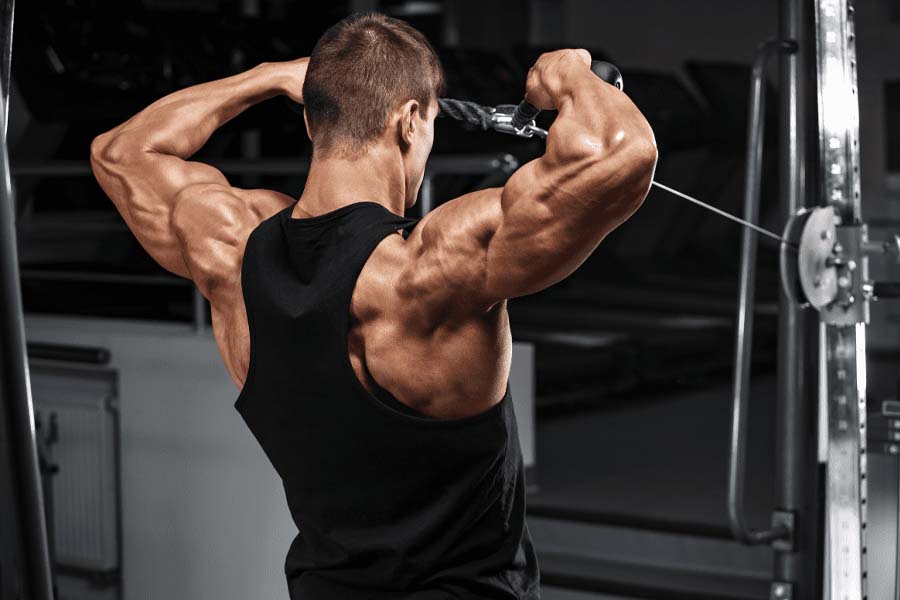
The Face Pulls exercise primarily focuses on the rear deltoids, traps, and upper back muscles. It is a versatile exercise that can be incorporated into various training routines for enhancing strength, posture, and overall shoulder health.
To perform the Face Pulls exercise, follow these steps:
- Set up a cable machine with a tricep rope attachment at eye level or slightly above.
- Stand facing the cable machine with your feet shoulder-width apart, and firmly grasp the ropes with an overhand grip (palms facing down).
- Step back to create tension in the cable while maintaining an athletic stance with the knees slightly bent and the chest lifted.
- Begin the pulling motion by initiating your shoulder blades' retraction while driving your elbows out and back in a rowing motion.
- During the pull, externally rotate your shoulders, keeping your wrists neutral throughout the movement. Aim to pull the ropes apart and towards your ears so your palms face each other and your elbows stay above shoulder height.
- Pause momentarily at the peak of the contraction, focusing on squeezing your shoulder blades together and maintaining tension in the targeted muscle groups.
- Slowly reverse the movement by extending your arms to the starting position, maintaining control over the cable's tension.
- 8. Repeat the exercise for the desired number of repetitions, typically ranging from 10-15 reps for 3-4 sets.
6. Overhead Press
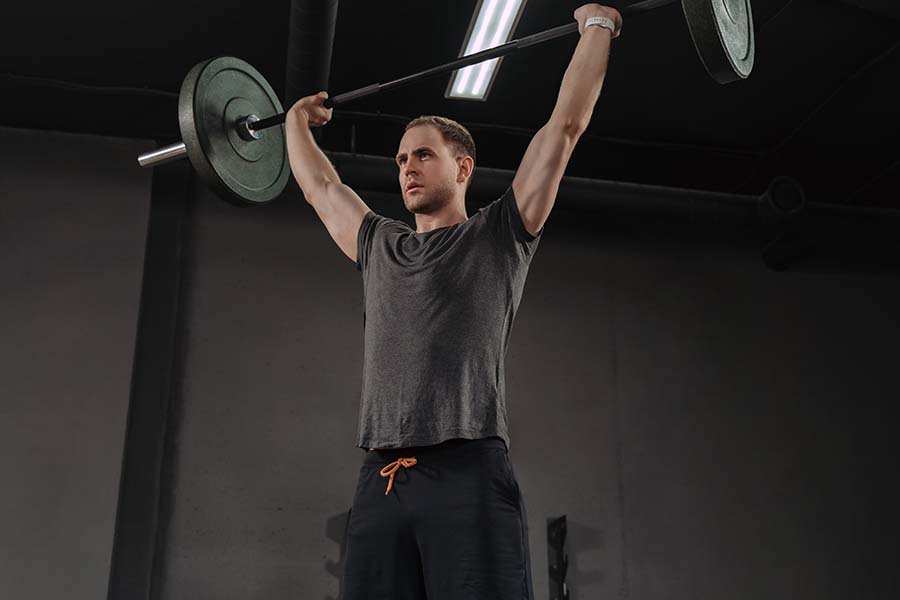
The overhead press is a highly effective upper body exercise that targets several muscle groups, providing numerous benefits to those who incorporate it into their fitness routine.
How to Perform the Overhead Press:
- Start by standing with your feet shoulder-width apart and a slight bend in your knees. Hold a barbell or dumbbell at shoulder height, with your palms facing forward and elbows tucked in close to your body.
- Engage your core and maintain a neutral spine as you press the weight overhead. Ensure that your lower back does not arch excessively during this movement.
- Continue pressing the weight until your arms are fully extended overhead, with your biceps in line with your ears. Make sure to keep your wrists straight and directly above your shoulders
- Slowly lower the weight back to the starting position, maintaining control throughout the descent. Keep your chest lifted and your shoulder blades retracted to maintain proper posture.
- Repeat the movement for the desired repetitions, focusing on proper form and technique. To ensure optimal results and minimize the risk of injury, it is crucial to progress gradually by increasing weight or repetitions over time.
7. Seated Behind the Neck Press
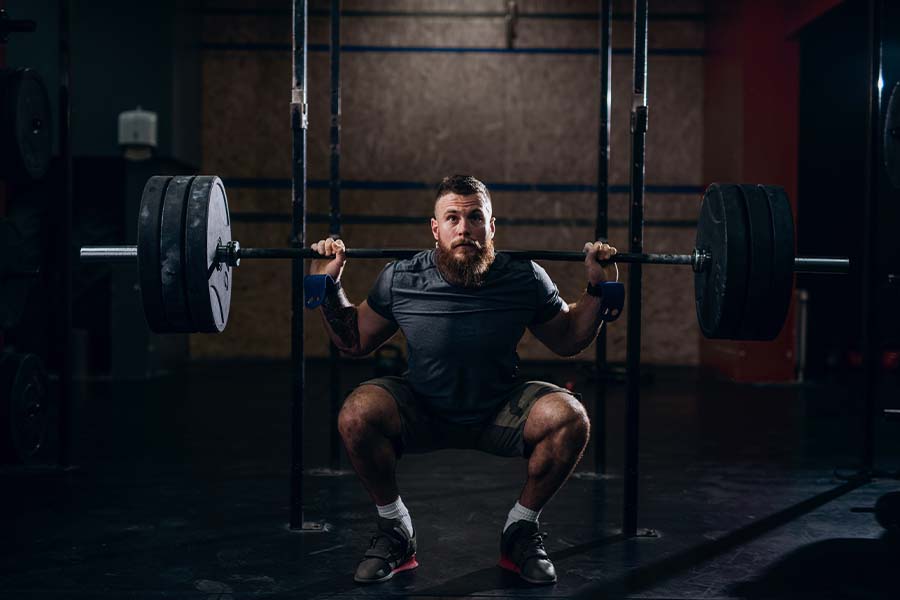
The Seated Behind the Neck Press is an effective and potent upper body exercise that primarily targets the deltoid muscles while also engaging the triceps, upper back, and trapezius muscles.
How to Perform the Seated Behind the Neck Press:
- Select an appropriate weight in the form of a barbell or a Smith machine. Start with a lighter weight to warm up and familiarize yourself with the correct technique.
- Sit on an upright bench with a backrest and ensure your feet are flat on the ground, providing stability.
- Grip the barbell or Smith machine with a slightly wider than shoulder-width grip, placing the bar behind the neck and resting it on the upper traps. The palms should be facing forward, and the elbows at 90 degrees.
- Engage the core muscles and maintain a neutral spine (avoid overarching the lower back) as you press the weight upwards in a controlled motion, fully extending the arms.
- At the top of the movement, pause briefly before slowly lowering the bar back down to the starting position, maintaining control of the weight throughout the descent.
- Repeat for a desired number of repetitions, typically between 8-12 reps for 3-4 sets, while focusing on proper form and control.
8. Incline Lateral Raise
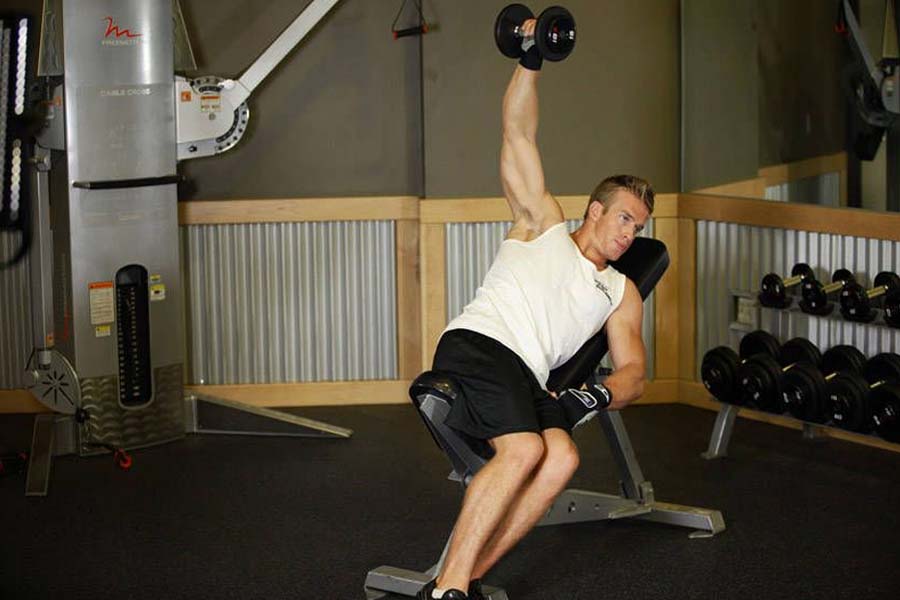
The Incline Lateral Raise is an effective exercise that targets the shoulders, specifically the lateral or medial deltoid muscles, and provides numerous benefits when incorporated into a workout routine.
How to Perform the Incline Lateral Raise:
- Set up an adjustable incline bench to around a 45-degree angle.
- Grab a dumbbell with a comfortable yet challenging weight, and lay on the bench at your side.
- Engage your core and maintain a straight back while leaning against the incline bench.
- With a slight bend in your elbows, slowly raise the dumbbell laterally until it is in line with your shoulders. Ensure you maintain control during the movement and do not swing the weight with momentum.
- Pause for a second at the top of the movement before slowly lowering the weight back down to the starting position.
- Repeat the exercise for the desired number of repetitions, typically 8-12 reps for 3-4 sets.
9. Front Raises
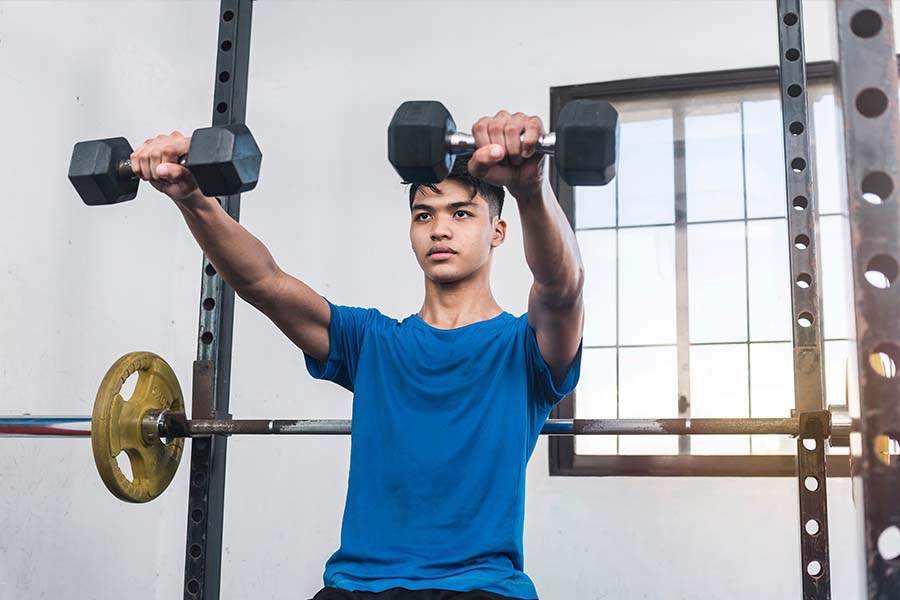
Front raises are an effective and versatile isolation exercise that primarily targets the front part of the deltoids, also known as the anterior deltoids. This exercise is essential for anyone looking to improve their overall shoulder strength, stability, and aesthetics.
To perform front raises with proper form, follow these steps:
- Stand upright with your feet shoulder-width apart. Hold a dumbbell or barbell in each hand with a firm neutral grip (palms facing toward your body).
- Extend your arms straight in front of you so that the weights rest against your thighs. This is your starting position. Engage your core and keep your back straight throughout the exercise.
- Slowly raise the weights straight up in front of your body, maintaining a slight bend in your elbows. Keep your wrists in a neutral position, and avoid using momentum or swinging the weights.
- Continue raising the weights until your arms are parallel to the floor and the weights are at shoulder level. Pause briefly at the top of the movement to ensure maximum muscle activation.
- Slowly lower the weights back down to the starting position in a controlled manner. Repeat the movement for the desired number of reps.
10. Push-Ups
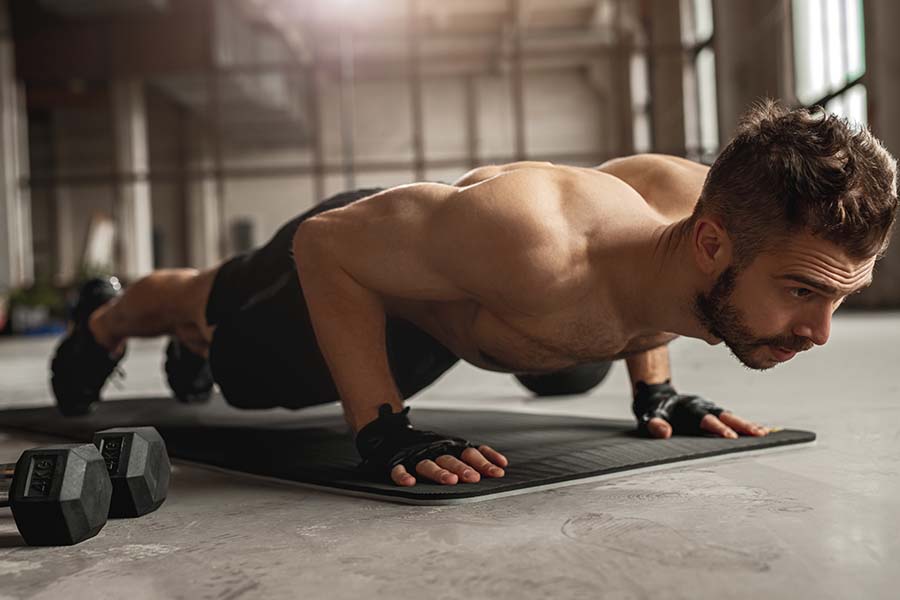
Push-up exercises are an excellent way to target and strengthen the shoulders alongside other muscle groups, such as the chest, triceps, and core muscles. Incorporating push-ups into your exercise routine can benefit your overall muscle development, posture, and flexibility.
How to Perform a Push-up:
- Start by positioning yourself face down on the ground, ensuring that your hands are slightly wider than shoulder-width apart. Your fingers should point forward, and your legs should be straight, resting on your toes.
- Tighten your core muscles and maintain a straight line from your head to your heels throughout the exercise. This position is called a plank.
- Begin the movement by lowering your body until your chest gently touches the ground. Keep your elbows at a 45-degree angle to your body and avoid flaring them outward. Your shoulder blades should come together as you descend.
- Push yourself back up to the starting plank position by straightening your arms and engaging your chest, shoulder, and tricep muscles.
- Repeat the movement for your desired number of repetitions, ensuring proper form and muscle engagement.
Conclusion
In conclusion, attaining broader and more impressive shoulders is a goal that can be achieved through consistent and targeted exercise routines. Incorporating the 10 specific exercises mentioned above, which engage various muscle groups such as the deltoids, trapezius, and rotator cuff muscles will help increase the shoulder width and improve overall body strength and posture.
With the right form and progressive overload, these exercises can stimulate muscle growth, enhance the V-taper appearance, and prevent injury. Prioritizing shoulder exercise and development can also improve athletic performance in various sports, making it an essential aspect of well-rounded fitness routines for individuals striving for optimal physical performance and appearance.





